Intel SSD DC P3700 Review: The PCIe SSD Transition Begins with NVMe
by Anand Lal Shimpi on June 3, 2014 2:00 AM EST- Posted in
- Storage
- SSDs
- Intel
- Intel SSD DC P3700
- NVMe
Sequential Read Performance
Sequential operations still make up a substantial portion of enterprise storage workloads. One of the most IO heavy workloads we run in AnandTech's own infrastructure are our traffic and ad stats processing routines. These tasks run daily as well as weekly and both create tremendous IO load for our database servers. Profiling the workload reveals an access pattern that's largely sequential in nature.
We'll start with a look at sequential read performance. Here we fill the drive multiple times with sequential data and then read it back for a period of 3 minutes. I'm reporting performance in MB/s as well as latency over a range of queue depths. First up, bandwidth figures:
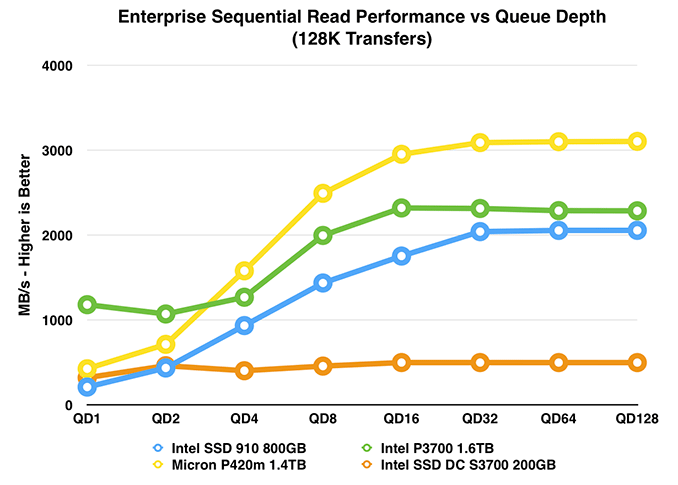
The biggest takeaway from this graph is just how much parallelism Intel manages to extract from each transfer even at a queue depth of 1. The P3700 delivers more than 1GB/s of bandwidth at QD1. That's more than double any of the other competitors here, and equal to the performance of 3.7x SATA Intel SSD DC S3700s. Note that if you force the P3700 into a higher power, 25W operating mode, Intel claims peak performance hits 2.8GB/s compared to the 2.2GB/s we show here.
With NVMe you get a direct path to the PCIe controller, and in the case of any well designed system the storage will communicate directly to a PCIe controller on the CPU's die. With a much lower overhead interface and protocol stack, the result should be substantially lower latency. The graph below looks at average
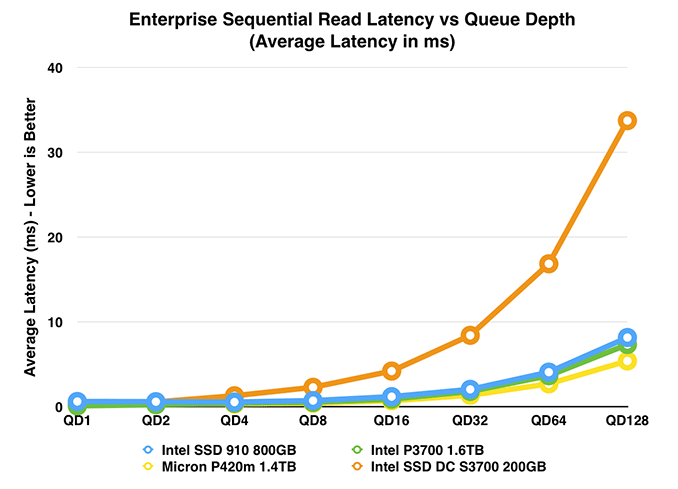
The P3700 also holds a nice latency advantage here. You'll be able to see just how low the absolute latencies are in a moment, but for now we can look at the behavior of the drives vs. queue depth. The P3700's latencies stay mostly flat up to a queue depth of 16, it's only after QD32 that we see further increased latencies. The comparison to the SATA based S3700 is hilarious. The P3700's IO latency at QD32 is lower than the S3700 at QD8.
The next graph removes the sole SATA option and looks at PCIe comparisons alone, including the native PCIe (non-NVMe) Micron P420m:
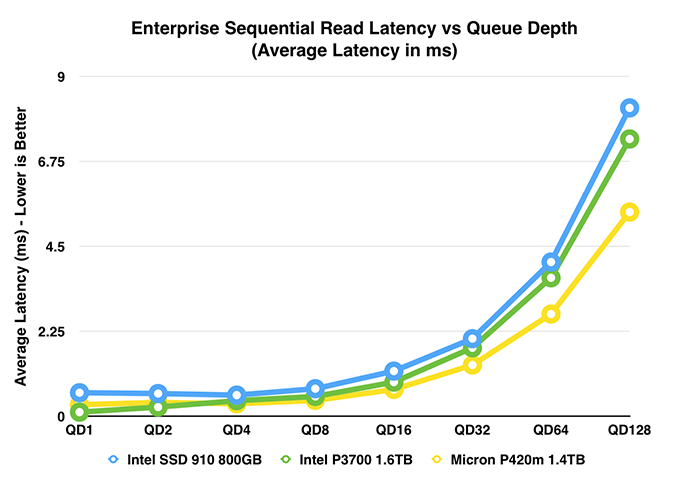
Micron definitely holds the latency advantage over Intel's design at higher queue depths. Remember that the P420m also happens to be a native PCIe SSD controller, it's just using a proprietary host controller interface.
Sequential Write Performance
Similar to our discussion around sequential read performance, sequential write performance is still a very valuable metric in the enterprise space. Large log processing can stress a drive's sequential write performance, and once again it's something we see in our own server environment.
Here we fill the drive multiple times with sequential data and then write it back for a period of 3 minutes. I'm reporting performance in MB/s as well as latency over a range of queue depths.
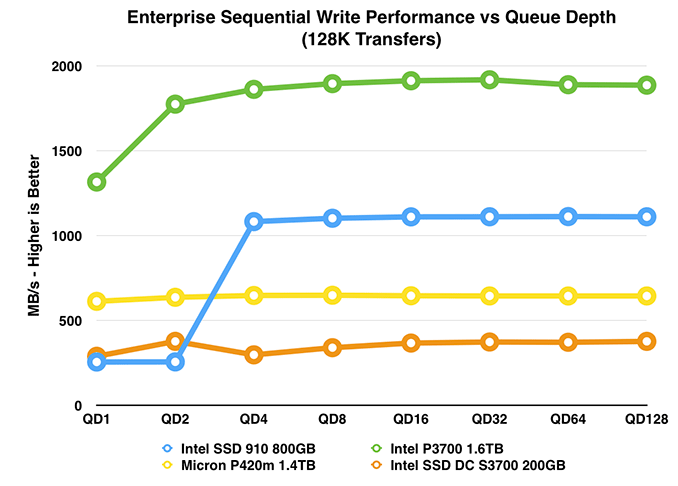
Once again we see tremendous performance at very low queue depths. At a queue depth of 1 the P3700 already performs better than any of the other drives here, and delivers 1.3GB/s of sequential write performance. That's just insane performance at such a low queue depth. By QD4, the P3700 reaches peak performance at roughly 1.9GB/s regardless of what power mode you operate it in.
The chart below shows average latency across the QD sweep:
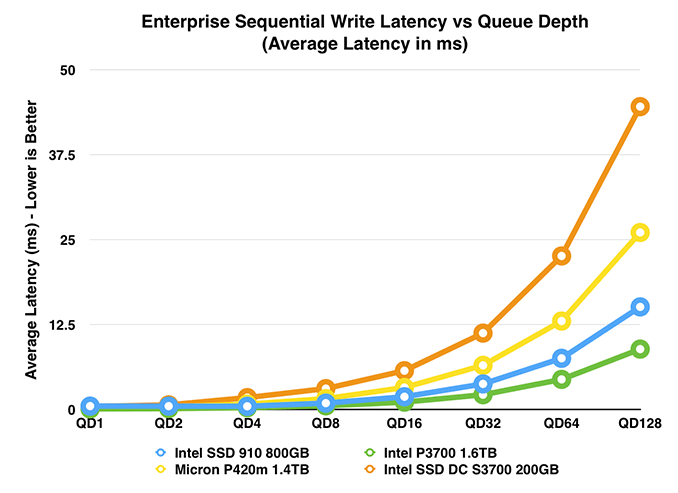
The P3700 continues to do extremely well in the latency tests, although Intel's original PCIe SSD didn't do so badly here either - its bandwidth was simply nowhere as good. Another way to look at it is that Intel now delivers better latency than the original 910, at substantially higher bandwidths. Micron's P420m manages to land somewhere between a good SATA drive and the P3700.
The next chart just removes the SATA drive so we get a better look at the PCIe comparison:
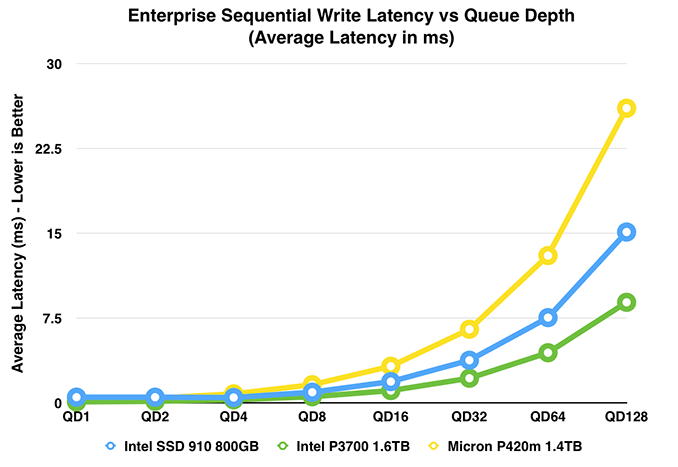










85 Comments
View All Comments
gospadin - Tuesday, June 3, 2014 - link
tRead on MLC NAND is > 50us. 10us latency will never be achievable with an MLC NAND back-end without a redesign of the NAND array.mavere - Friday, June 6, 2014 - link
"I am angry because my ridiculous fantasies aren't fulfilled."Antronman - Tuesday, June 3, 2014 - link
Fusion iO blows it all away.TelstarTOS - Tuesday, June 3, 2014 - link
did they make it bootable on windows after what 8 years?extide - Tuesday, June 3, 2014 - link
At what cost?I'd definitely like to see some FusionIO benches on this site...
TelstarTOS - Tuesday, June 3, 2014 - link
At last Intel showed its muscles again.If in a 6 month timeframe something similar and cheaper doesnt come out, the 400GB P3600 will be my next SSD. Looking forward SF3700 really curiously now.
Kevin G - Tuesday, June 3, 2014 - link
I love the raw speed that this delivers. It does not hold anything back in terms of performance. I'm genuinely excited as to what a full blown server implementation using 16x PCIe 3.0 could provide.My only issue is one of capacity and cost per GB of storage. It is good to see 2 TB solutions but honestly I was hoping for a bit more. Moving away from the 2.5" SATA, M.2 and mSATA formats should enable far more NAND packages. I can see Intel limiting these consumer/prosumer cards to lower capacities to keep the higher capacity units in the enterprise space where ultra fast storage carries a higher premium. Speaking of costs, I was prepared to accept this as costing a bit more but not this much. Things like moving to an 18 channel design and the cost of the NVMe controller would be more expensive but not quiet this much. I was hoping to see something closer to $1/GB as the 2.5" SATA market is well below that and starting to approach $0.50/GB. Speed can carry a premium but those lower $/GB SATA drives are still pretty fast on their own.
Actually are there any subjective impressions? Does the P3700 feel noticeably faster in day-to-day usage than a generic 2.5" SATA SDD?
I'd also like to see some boot testing. Generally there are some quirks here and there that crop up with technology introductions.
kaix2 - Tuesday, June 3, 2014 - link
with the p3700 drive rated at 10dw/d it's aimed at high end enterprise. expecting $1/GB for this high end of a drive isn't realistic. also it's not a fair comparison if you simply compare the price of this drive to an average consumer sata drive and not take nand endurance and quality into account.Sacco_svd - Tuesday, June 3, 2014 - link
P3700 / 2048gb*3dollar = 6144 dollarsP3500 / 2048gb*1.469dollar = 3061.76 dollars
If those are going to be the prices they're still not competitively cheap, by a big margin.
balindad - Tuesday, June 3, 2014 - link
As mentioned else where, could you drop this in on any open pcie and have it work and bootable with no other upgrades needed as long as you're running windows 8?